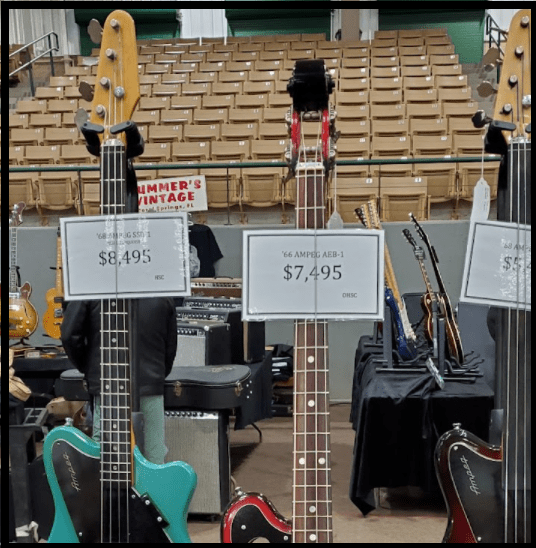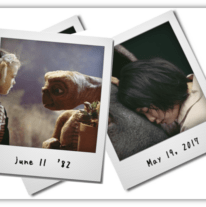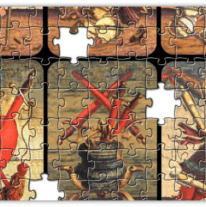Franklin TN, March 26, 2022
Non-musicians can usually tell the difference between an acoustic guitar and an electric guitar. Sometimes that’s all they notice. Guitarists, on the other hand, can see a performer on television and be able to tell you not just the make and model, but the year.
It’s like cars. A 1966 Ford Mustang is very different from a 1972 Ford Mustang. And a 1957 Fender Stratocaster is very different from a 1983 Stratocaster.
These things matter to guitarists. Hence, the guitar show; specifically, the 2022 Nashville stop of the famous Amigo Guitar Show. Similar to a car show or a boat show, musicians can walk from booth to booth looking at instruments and equipment, old and new, workhorses and collectors items, cheap and really, really expensive. Most of us walk through twice to make sure we didn’t miss anything, like kids in a toy store.
I was mostly interested in bass guitars and effects, but I tried to get pictures of anything interesting. Having said that, there were over a thousand instruments and this only scratches the surface. Let’s begin.
I was interested in the Fender because those high mass pickups sound huge, but I already have a bass with a similar set up.
This blue was popular but they also offered black and red.
Behind the translucent top are colored lights that flash depending on which string you play.
This video is a good demonstration of it: https://youtu.be/eSt1WdxoxxE
Some models came in a case that had a built-in amplifier. There were at least three of these at the show.
Their goal is to get young girls interested in playing music. It seems to be working.
This is the booth I spent the most time in. I’ve always loved Ampeg basses but they’re rare and I’ve only ever seen a few. Here’s six of them all in the same place, and there’s a few more in their cases under the table.
The dealer had purchased 52 Ampeg basses from a single collector. He showed me a photo of the entire collection and my jaw dropped. They were only made from 1966 to 1969, and this guy had somehow got 52 of them.
The smaller basses in the back are the SSB and SSUB models. The “SS” stands for “short scale” which means the length of the strings is 30” rather than the standard 34” inches. This gives the instrument a boomier sound. The “U” in “SSUB” means “unfretted.” It’s unclear how many were made, but they’re very rare.
The bass in front is notable for the F-holes that go all the way through the body, the “mystery” pickup that is entirely hidden under the bridge, and the scroll headstock. This one is an AEB-1 but the whole series of them is nicknamed as the “scroll bass.” The first one I saw was played by Boz Burrell of Bad Company on Don Kirschner’s Rock Concert.
Ampeg made only 100 “Devil” basses. 75 were fretted, 25 were unfretted. The collector had two of each. There are so few of them that I had never seen one in person, and here were two right in front of me. $7500 each, which the research I’ve done since shows to be a fair price.
I seriously considered getting one as an investment. It would never leave the house, and mostly stay in its case until the value goes up enough to be worth selling. I stipulate in my will that my son gets all of my music equipment when I die, so a rare bass like this might be a nice inheritance for him.
Yet, I’ve always believed that instruments should be played. I can’t imagine such a beautiful bass just sitting in a closet. At the same time, I can’t picture bringing a Devil bass to a honky tonk or a punk club or on tour. It’s much too valuable to bring it anywhere it could be damaged or stolen. So I’m letting this one slip through my fingers.
When I walked into the show, I was hoping to get some parts I need to build a bass but I didn’t find any. And I thought I might find an effects pedal or a bass with a coolness factor. I ended up not buying anything, not even a vacuum tube night light, and that’s how it goes at these things. Sometimes you find the instrument you always wanted, sometimes you even buy it, and sometimes come to your senses and don’t get anything. And you tell yourself that’s the right thing to do.
However, I do have the dealer’s business card.
Let the author know that you liked their article with a ‘heart’ upvote!





I feel like I just got a personal tour at a bass guitar museum, that was awesome VDog! Thank you for thinking of our happy place here and sharing all that with us; I loved it.
Wow! Thanks for this really cool look at this show, V-dog. Some of the novelties like the Budweiser guitar aside, the one that really made my jaw drop was the harp guitar. Not being a musician, I’ve never seen anything like it, and was wondering how one plays it: using one hand to go between the two parts, or seated, using both hands, one on the harp part and the other on the guitar part? (You can tell my lack of musical knowledge here…)
There are a ton of videos on harp guitars. Here’s a demonstration by a maker: Demonstration
And here’s a lovely orchestra: The Water is Wide
I’ve never played one either but my understanding it’s played just like a guitar and the extra strings ring in sympathy with the regular strings. However, they can also be occasionally plucked as seen in this clip from The Last Waltz.
Those are called “drone strings,” I think. Sort of like on this electric sitar?
Yes, that’s right, and I may be wrong about the extra strings on a harp guitar being drones. The players in the videos Archie posted are using them for bass notes.
Agreed. I just stopped at the 1916 harp guitar, and thought, “This may be the coolest thing that I have ever seen.” I had never even heard of one, but I absolutely love it.
I agree with everyone else… I don’t know jack about most musical instruments, but I could spend all day just staring at those harp guitars.
I would’ve loved being there checking out the gear with you. I see a very old Spanish guitar humbly sitting on the floor in front of the Les Pauls – out of my price range, but ready for someone to pick up.
Speaking of beautiful Spanish guitar craft…
https://www.youtube.com/watch?v=YDvcKMC5nEg&lc=UgySrCmjh7QrpQzCKMN4AaABAg
I think that Rickenbacker 331LS Lightshow might be an idea whose time has returned. I bet with modern LEDs and and Arduino or Rasberry Pi controller, you could build something that produces incredible displays in time with the music, a guitar with a built-in visualizer.
You could be right! And if Rickenbacker doesn’t do it, Eastwood might.